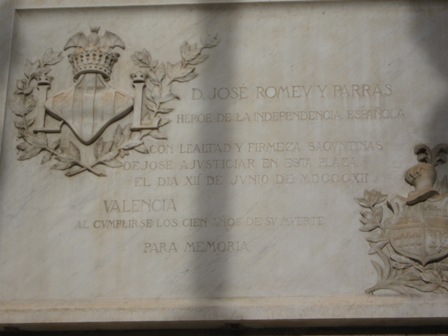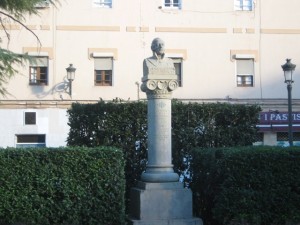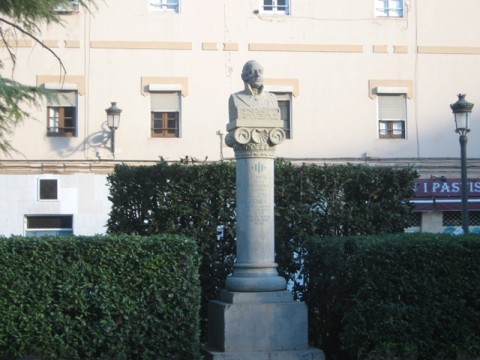A portrait of José Romeu y Parras hangs in the office of the Mayor of Sagunto, a town of Roman origin with an impressive castle just north of Valencia.
 José Romeu y Parras was born in Sagunto, then called Murviedro, in 1778.
José Romeu y Parras was born in Sagunto, then called Murviedro, in 1778.
Following the Spanish uprising against the French occupation in May 1808, José was one among many young Spaniards who joined the Spanish militias to resist Napoleon’s armies.
Romeu was put in charge of the Sagunto militia and managed to recruit 2,000 fighters
Marching to Valencia, then under siege, Romeu’s men participated in the victory against the French army, after which he returned to Sagunto to study military tactics.
From September 1808, Romeu was in Madrid on family business when Napoleon’s troops once more attacked, and Madrid was taken. Romeu fought with the city’s defenders under General Manuel Miranda Gayoso, by whom he was assigned the role of defending the gates of Recoletos and Veterinaria.
When the French entered Madrid, Romeu was wounded escaping the city.
 In 1809 he was Captain of the Compañía de Granaderos and participated in the relief of Morella, which was under siege. Afterwards he was sent to Teruel, where he ambushed various French supply columns.
In 1809 he was Captain of the Compañía de Granaderos and participated in the relief of Morella, which was under siege. Afterwards he was sent to Teruel, where he ambushed various French supply columns.
In March 1810, when Marshal Suchet moved on Valencia again, Romeu’s troops harassed their rearguard.
During the Spanish defeat at the Battle of Sagunto in October 1811 Romeu defended the vital bridge over the River Turia at Ribarroja del Turia.
Following this defeat, Romeu went to Alicante, while his wife and three sons hid in the mountains from the vengeance of the French occupying force.
In 1812 he organised various uprisings among the villages of Alicante and fought the French all over the province and in the west of Valencia province.
The French soon realised that Romeu was a serious tactician and able to rouse the Spanish sense of patriotism and began to actively hunt him down.
Romeu then centred his actions around Albacete and Cuenca.
He inflicted various defeats upon the French generals Maupoint and Paris, after which they tried to buy his services, offering all kinds of temptations.
After defeating French forces at Buñol and Dos Aguas, Marshal Suchet decided to employ betrayal and a Spaniard known as ‘Recelós’ informed the French that Romeu would be spending the night in Sot de Chera with only 40 cavalry.
1,800 French soldiers trapped him there and he was taken to Valencia, where the French attempted to persuade him to support their cause. Romeu refused, even when he was sentenced to death and on the 12th June 1812 he was hanged on the site of what is now the Central Market of Valencia. A plaque on the wall of La Lonja commemorates this fact.
He was buried in the cemetery for executed felons at Tavernes Blanques.
Today a statue honours him in the Glorieta of Sagunto and a park and public school, C.P. José Romeu, are named after him, while in Valencia there is a bust of him in Calle Lerida by the sculptor Florencio Ramón.

